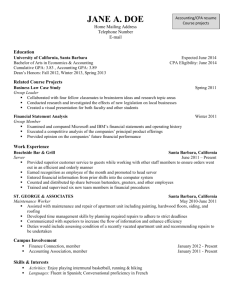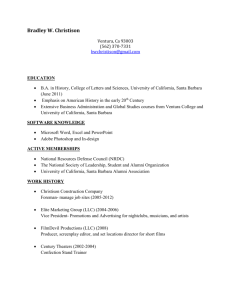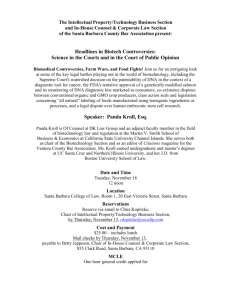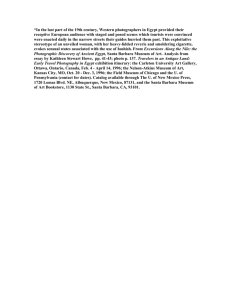Joint Minutes 02-23-04
advertisement
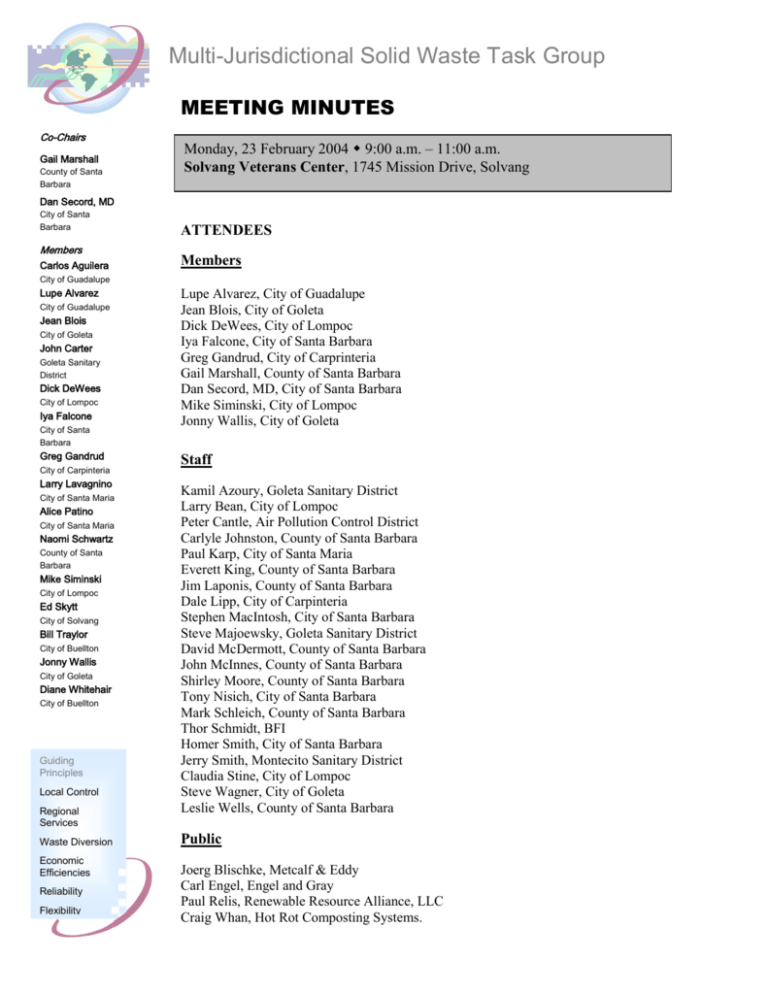
Multi-Jurisdictional Solid Waste Task Group MEETING MINUTES Co-Chairs Gail Marshall County of Santa Barbara Monday, 23 February 2004 9:00 a.m. – 11:00 a.m. Solvang Veterans Center, 1745 Mission Drive, Solvang Dan Secord, MD City of Santa Barbara Members Carlos Aguilera ATTENDEES Members City of Guadalupe Lupe Alvarez City of Guadalupe Jean Blois City of Goleta John Carter Goleta Sanitary District Dick DeWees City of Lompoc Iya Falcone City of Santa Barbara Greg Gandrud City of Carpinteria Larry Lavagnino City of Santa Maria Alice Patino City of Santa Maria Naomi Schwartz County of Santa Barbara Mike Siminski City of Lompoc Ed Skytt City of Solvang Bill Traylor City of Buellton Jonny Wallis City of Goleta Diane Whitehair City of Buellton Guiding Principles Local Control Regional Services Waste Diversion Economic Efficiencies Reliability Flexibility Reliability Flexibility Lupe Alvarez, City of Guadalupe Jean Blois, City of Goleta Dick DeWees, City of Lompoc Iya Falcone, City of Santa Barbara Greg Gandrud, City of Carprinteria Gail Marshall, County of Santa Barbara Dan Secord, MD, City of Santa Barbara Mike Siminski, City of Lompoc Jonny Wallis, City of Goleta Staff Kamil Azoury, Goleta Sanitary District Larry Bean, City of Lompoc Peter Cantle, Air Pollution Control District Carlyle Johnston, County of Santa Barbara Paul Karp, City of Santa Maria Everett King, County of Santa Barbara Jim Laponis, County of Santa Barbara Dale Lipp, City of Carpinteria Stephen MacIntosh, City of Santa Barbara Steve Majoewsky, Goleta Sanitary District David McDermott, County of Santa Barbara John McInnes, County of Santa Barbara Shirley Moore, County of Santa Barbara Tony Nisich, City of Santa Barbara Mark Schleich, County of Santa Barbara Thor Schmidt, BFI Homer Smith, City of Santa Barbara Jerry Smith, Montecito Sanitary District Claudia Stine, City of Lompoc Steve Wagner, City of Goleta Leslie Wells, County of Santa Barbara Public Joerg Blischke, Metcalf & Eddy Carl Engel, Engel and Gray Paul Relis, Renewable Resource Alliance, LLC Craig Whan, Hot Rot Composting Systems. Supervisor Marshall convened the meeting at 9:08 a.m. Introductions were made. Councilman Secord moved to adopt the minutes of the January 26, 2004 MultiJurisdictional Solid Waste Task Group (MJSWTG) meeting. Councilwoman Blois seconded the motion, which was approved with Supervisor Marshall, Mayor Dewees and Councilman Alvarez abstaining. Mark Schleich presented the conceptual final recommendations to the group. After a brief review of the past two years’ work and the Technical Advisory Committee Guidelines, the following countywide recommendations were made: Increase commercial recycling Provide for the collection of E-waste (statewide mandate) Pass a Construction and Demolition (C&D) debris Ordinance (by wasteshed) Develop a Clean Material Recovery Facility (MRF) on the South Coast to provide a local option for the County Recommendations for the Lompoc Wasteshed include: Implementation of a C&D Ordinance Increasing participation in commercial recycling Increasing E-waste collection Support for a local countywide clean MRF Recommendations for the Santa Maria Wasteshed include: Optimizing funding for closure, free recycling and facility replacement planning Additional recycling programs at the landfill site Integrated recycling and transfer station Developing long-term disposal solution for non-recyclables/special wastes Support for a countywide clean MRF Recommendations for the Tajiguas Wasteshed include: Expansion of existing recycling programs Development of a Clean MRF Developing a food waste collection and processing infrastructure Implementation of a C&D Ordinance Siting a new permanent household hazardous waste facility Expanding E-waste collection programs Siting a new Conversion Facility System scenarios that were considered by the TAC included: Existing system (no changes/modifications) A “Dirty” MRF/Composting Facility with new Community Programs A “Dirty” MRF/Conversion Facility with new Community Programs The annual net cost of maintaining the existing system is $7.3 million, with a $27 per ton cost. South Coast diversion under the existing system is 55%, and the projected life of the Tajiguas landfill at current fill rates is 18 years. A “Dirty” MRF/Composting facility would cost between $7.6-$10.7 million with a per ton cost of $28-$40. South Coast diversion would increase to 74%, and the projected life of the Tajiguas landfill would increase to 29 years. A “Dirty” MRF/Conversion facility would cost between $7.3-$11.5 million with a per ton cost of $27-$42. South Coast diversion would increase to 83-88%, and the projected life of the Tajiguas landfill would be 41-53 years. The TAC and Project Team recommendation for the Tajiguas Wasteshed calls for: Expansion of community programs New “Clean” MRF for commingled recyclables processing “Dirty” MRF/Conversion facility, OR if infeasible a “Dirty” MRF/Composting facility Following approval of the TAC recommendations by the MJSWTG, the next steps involve presenting the work of the MJSWTG and its recommendations to the respective Boards and Councils. With respect to the future of the MJSWTG itself possibilities include disbanding, forming a new Task Group, or breaking up into smaller wasteshed groups. Regarding conversion technologies, Councilman Secord wondered if it made sense for us to wrestle with it now or defer a decision until these technologies gain more of a track record. John McInnes answered that the TAC addressed conversion technologies in the context of remaining life of the Tajiguas landfill. Delaying the implementation of the TAC recommendations will reduce the landfill’s current permitted capacity. Paul Relis added that the California Integrated Waste Management Board (CIWMB), and the University of California at Davis and Riverside are currently conducting a fairly extensive study of conversion technologies. The final study is expected to be completed in the next 60-90 days. Steve Wagner asked what the proposed new community programs contribute to the overall projected increase in diversion. In the Tajiguas wasteshed, new community programs are estimated to contribute 5% to the projected diversion. This could be higher in the Lompoc and Santa Maria wastesheds. Supervisor Marshall noted that these recommendations represent an aggressive effort on the part of all the participants and is very impressive, and supports having quarterly MJSWTG meetings with the subgroups to meet as needed. The issue of siting proposed facilities should now be addressed. She also noted that these recommendations are a good response to a recent editorial that appeared in the Santa Barbara News Press, criticizing the County for a lack of creativity with respect to solid waste management. Councilwoman Falcone concurred with Supervisor Marshall, and expressed a hope that there was more the different jurisdictions in the county could cooperate on. She asked what the group expected to come out of the presentations to the various councils and boards. Jim Laponis responded that staff’s proposal was to ask the different jurisdictions to adopt the conceptual plan presented today. David McDermott added that the MJSWTG is an advisory body only, and that in order to proceed, governance issues need to be worked out such as finances, flow control, facility siting, etc, requiring some mechanism such as a Joint Powers Agreement, Joint Resolution, or some other contractual arrangement. Mayor DeWees noted that the action before the Task Group is to receive and approve the Conceptual Plan, which is somewhat vague; the councils and boards will ask questions regarding cost. Councilwoman Blois added that councils will want to hear more about governance issues. David McDermott responded that a broad outline of the various governance options could be provided as part of the presentations to be made to the councils. Councilwoman Falcone moved to approve the conceptual plan, as presented by the TAC. The motion was seconded by Councilman Secord and was unanimously approved. Councilwoman Wallis moved to direct the TAC and the Solid Waste Project Team to coordinate with the various jurisdictions to make presentations on the Countywide Longterm Solid Waste Plan. The motion was unanimously approved. Councilman Secord then took up the question of how to proceed? Jim Laponis proposed that the MJSWTG meet again in May, following the presentations that will be made to the Board of Supervisors and City Councils. Councilwoman Falcone moved that the MJSWTG meet on May 17, 2004 following the presentations to be made to the various jurisdictions, as recommended. Mayor DeWees wondered if a May meeting would provide suitable time to make these presentations. Councilman Secord seconded the motion, which passed unanimously. Councilwoman Falcone requested that a matrix be developed for the presentations that would show where jurisdictions are planning to cooperate both countywide and within wastesheds. Craig Whan felt that such a matrix might help clarify for jurisdictions what their “share” in the proposed system would be. The meeting adjourned at 10:30 a.m. NEXT MEETING Monday, May 17, 2004, 9:00 a.m. to 11:00
